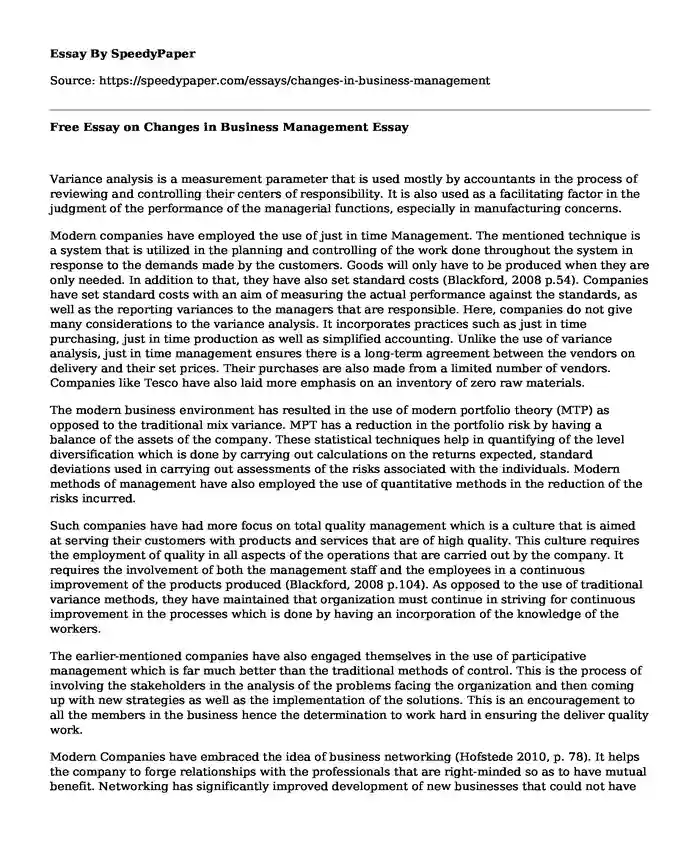
| Type of paper: | Essay |
| Categories: | Business management |
| Pages: | 3 |
| Wordcount: | 687 words |
Variance analysis is a measurement parameter that is used mostly by accountants in the process of reviewing and controlling their centers of responsibility. It is also used as a facilitating factor in the judgment of the performance of the managerial functions, especially in manufacturing concerns.
Modern companies have employed the use of just in time Management. The mentioned technique is a system that is utilized in the planning and controlling of the work done throughout the system in response to the demands made by the customers. Goods will only have to be produced when they are only needed. In addition to that, they have also set standard costs (Blackford, 2008 p.54). Companies have set standard costs with an aim of measuring the actual performance against the standards, as well as the reporting variances to the managers that are responsible. Here, companies do not give many considerations to the variance analysis. It incorporates practices such as just in time purchasing, just in time production as well as simplified accounting. Unlike the use of variance analysis, just in time management ensures there is a long-term agreement between the vendors on delivery and their set prices. Their purchases are also made from a limited number of vendors. Companies like Tesco have also laid more emphasis on an inventory of zero raw materials.
The modern business environment has resulted in the use of modern portfolio theory (MTP) as opposed to the traditional mix variance. MPT has a reduction in the portfolio risk by having a balance of the assets of the company. These statistical techniques help in quantifying of the level diversification which is done by carrying out calculations on the returns expected, standard deviations used in carrying out assessments of the risks associated with the individuals. Modern methods of management have also employed the use of quantitative methods in the reduction of the risks incurred.
Such companies have had more focus on total quality management which is a culture that is aimed at serving their customers with products and services that are of high quality. This culture requires the employment of quality in all aspects of the operations that are carried out by the company. It requires the involvement of both the management staff and the employees in a continuous improvement of the products produced (Blackford, 2008 p.104). As opposed to the use of traditional variance methods, they have maintained that organization must continue in striving for continuous improvement in the processes which is done by having an incorporation of the knowledge of the workers.
The earlier-mentioned companies have also engaged themselves in the use of participative management which is far much better than the traditional methods of control. This is the process of involving the stakeholders in the analysis of the problems facing the organization and then coming up with new strategies as well as the implementation of the solutions. This is an encouragement to all the members in the business hence the determination to work hard in ensuring the deliver quality work.
Modern Companies have embraced the idea of business networking (Hofstede 2010, p. 78). It helps the company to forge relationships with the professionals that are right-minded so as to have mutual benefit. Networking has significantly improved development of new businesses that could not have been achieved by the use traditional methods of variance analysis as the methods focused on quantifiable and materials aspects of performance linked to budgets.
They have also made human resource management as their driver towards achieving success for the company. It deals with the behavior of the staff as this has a great impact on the profits and losses generated by the activities carried out in the Company. This is a unique strategy that has been used by modern companies as opposed to the traditional labor mix variance analysis whereby the behavioral aspects of the employees had not been much attention.
References
BLACKFORD, M. G. (2008). The rise of modern business: Great Britain, the United States, Germany, Japan, and China. Chapel Hill, University of North Carolina Press.
TER HOFSTEDE, A. (2010). Modern business process automation YAWL and its support environment. Heidelberg, Springer. http://site.ebrary.com/id/10351791.
Cite this page
Free Essay on Changes in Business Management. (2019, Aug 16). Retrieved from https://speedypaper.net/essays/changes-in-business-management
Request Removal
If you are the original author of this essay and no longer wish to have it published on the SpeedyPaper website, please click below to request its removal:
- Essay Example on The American Civil War
- Essay Sample on Effective Measures of Reducing the Use of Tobacco
- Essay Sample Dedicated to Bhopal Pesticide Plant Disaster
- Free essay on Ethnography Study: Cultural Domains (Drug Abuse among the Youth)
- Essay Sample on Human-Computer Interaction and User Frustration
- Free Essay Example on Policy Modification Process
- Outlining, Aristotle's Artistic Proofs, and Rhetorical Stance. Paper Example
Popular categories




